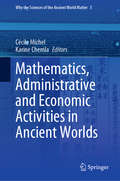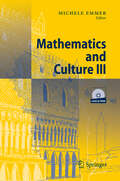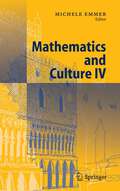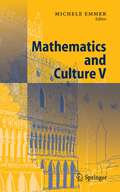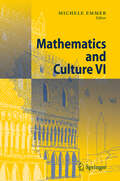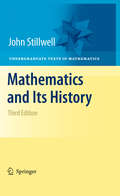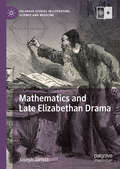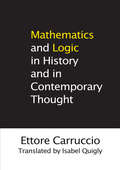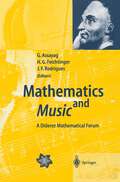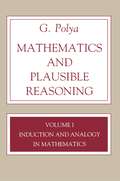- Table View
- List View
Mathematicians' Reflections on Teaching: A Symbiosis with Mathematics Education Theories (Advances in Mathematics Education)
by Sepideh StewartThis book opens the case on collaboration among mathematicians and mathematics educators. The authors of this book provide their research and experience based insights on collaboration to inspire the young generation of the mathematics community to engage in productive collaborations and exchange of knowledge early in their careers. These valuable collaborations are anticipated to generate innovative research questions that set new and novel paths for mathematics education research with ample possibilities yet to be realized and discovered.
Mathematicians under the Nazis
by Sanford L. SegalContrary to popular belief--and despite the expulsion, emigration, or death of many German mathematicians--substantial mathematics was produced in Germany during 1933-1945. In this landmark social history of the mathematics community in Nazi Germany, Sanford Segal examines how the Nazi years affected the personal and academic lives of those German mathematicians who continued to work in Germany. The effects of the Nazi regime on the lives of mathematicians ranged from limitations on foreign contact to power struggles that rattled entire institutions, from changed work patterns to military draft, deportation, and death. Based on extensive archival research, Mathematicians under the Nazis shows how these mathematicians, variously motivated, reacted to the period's intense political pressures. It details the consequences of their actions on their colleagues and on the practice and organs of German mathematics, including its curricula, institutions, and journals. Throughout, Segal's focus is on the biographies of individuals, including mathematicians who resisted the injection of ideology into their profession, some who worked in concentration camps, and others (such as Ludwig Bieberbach) who used the "Aryanization" of their profession to further their own agendas. Some of the figures are no longer well known; others still tower over the field. All lived lives complicated by Nazi power. Presenting a wealth of previously unavailable information, this book is a large contribution to the history of mathematics--as well as a unique view of what it was like to live and work in Nazi Germany.
Mathematics: From Creating the Pyramids to Exploring Infinity (Arcturus Fundamentals)
by Anne RooneyIn order to understand the universe you must know the language in which it is written. And that language is mathematics. - Galileo (1564-1642)People have always sought order in the apparent chaos of the universe. Mathematics has been our most valuable tool in that search, uncovering the patterns and rules that govern our world and beyond. This book traces humankind's greatest achievements, plotting a journey through the mathematical intellects of the last 4,000 years to where we stand today.It features the giants of mathematics, from Euclid and Pythagoras, through Napier and Newton, to Leibniz, Riemann, Russell, and many more.Topics include: • Counting and measuring from the earliest times• The Ancient Egyptians and geometry• The movements of planets• Measuring and mapping the world• Fuzzy logic and set theory• The death of numbersABOUT THE SERIES: Arcturus Fundamentals Series explains fascinating and far-reaching topics in simple terms. Designed with rustic, tactile covers and filled with dynamic illustrations and fact boxes, these books will help you quickly get to grips with complex topics that affect our day-to-day living.
Mathematics Across Cultures: The History of Non-Western Mathematics (Science Across Cultures: The History of Non-Western Science #2)
by Ubiratan D'AmbrosioMathematics Across Cultures: A History of Non-Western Mathematics consists of essays dealing with the mathematical knowledge and beliefs of cultures outside the United States and Europe. In addition to articles surveying Islamic, Chinese, Native American, Aboriginal Australian, Inca, Egyptian, and African mathematics, among others, the book includes essays on Rationality, Logic and Mathematics, and the transfer of knowledge from East to West. The essays address the connections between science and culture and relate the mathematical practices to the cultures which produced them. Each essay is well illustrated and contains an extensive bibliography. Because the geographic range is global, the book fills a gap in both the history of science and in cultural studies. It should find a place on the bookshelves of advanced undergraduate students, graduate students, and scholars, as well as in libraries serving those groups.
Mathematics, Administrative and Economic Activities in Ancient Worlds (Why the Sciences of the Ancient World Matter #5)
by Cécile Michel Karine ChemlaThis book focuses on the ancient Near East, early imperial China, South-East Asia, and medieval Europe, shedding light on mathematical knowledge and practices documented by sources relating to the administrative and economic activities of officials, merchants and other actors. It compares these to mathematical texts produced in related school contexts or reflecting the pursuit of mathematics for its own sake to reveal the diversity of mathematical practices in each of these geographical areas of the ancient world. Based on case studies from various periods and political, economic and social contexts, it explores how, in each part of the world discussed, it is possible to identify and describe the different cultures of quantification and computation as well as their points of contact. The thirteen chapters draw on a wide variety of texts from ancient Near East, China, South-East Asia and medieval Europe, which are analyzed by researchers from various fields, including mathematics, history, philology, archaeology and economics. The book will appeal to historians of science, economists and institutional historians of the ancient and medieval world, and also to Assyriologists, Indologists, Sinologists and experts on medieval Europe.
Mathematics and Culture II: Visual Perfection: Mathematics and Creativity
by Michele EmmerIn addition to mathematicians, this book is intended for a more general audience, for teachers and for researchers, for students in almost all topics, in particular in art, humanities, psychology, design and literature It is a truly interdisciplinary volume, and serves as a source for ideas and suggestions in several fields
Mathematics and Culture III
This work contains the proceedings of the "Mathematics and Culture" conference held in Venice in March 2002. The conference aims to act as a bridge across the various aspects of human knowledge. While keeping mathematics as its core, it is aimed at anyone endowed with cultural curiosity and interests, whether within or (even more so) outside mathematics. This volume therefore covers music, cinema, art, theatre and literature, with topics ranging from Tibet to comics.
Mathematics and Culture IV
Gaudi’s dream which will be reached finalizing the construction of the "Sagrada Familia" in Barcelona, the victory of the Swiss sail boat "Alinghi", which won America’s Cup, films such as " A Beautiful Mind" and "Enigma", the theatrical play based on the life of Galois, the images of the Dutch graphic artist M. C. Escher, crypotography, comics. What all these topics have in common? Mathematics, of course. This book focuses on the important role of mathematics in culture. It shows how very complex links between mathematics and culture can be not only interesting and stimulating but also fun.
Mathematics and Culture V
“I mean the third”cried the old man taking up the geometry book. “Well, young lady…”and he bent over his daughter. The princess gazed with terror into her father's keen eyes. He, on his part, got angry – pushed away his chair, dragged it back with a cl- ter – trying all the while to control himself; then again he would break out and storm, and wish the whole thing to the devil. As ill-luck would have it, to-day again his daughter answered at random and wrongly. “What an idiot!”he exclaimed, flinging down the book. The he rose, walked up and down, came back and stroked his daughter's hair, sat down again, and began his explanation once more. “It does not do, princess, it does not do”, he said, seeing her rise to leave him with VII the book in her hand. “Mathematics is a noble science, and I do not want you to be just like all the silly young ladies one meets. Persevere and you will learn to like the work, and the dullness will be nocked out of your brain. ” These words were spoken by Prince Andrei Bolkonskij, who was talking to Princess Marja Bolokonskaja, his daughter. They are two of the protagonists of Lev Tolstoy’s War and Peace, finished in 1869.
Mathematics and Information in the Philosophy of Michel Serres (Michel Serres and Material Futures)
by Vera BühlmannThis book introduces the reader to Serres' unique manner of 'doing philosophy' that can be traced throughout his entire oeuvre: namely as a novel manner of bearing witness.It explores how Serres takes note of a range of epistemologically unsettling situations, which he understands as arising from the short-circuit of a proprietary notion of capital with a praxis of science that commits itself to a form of reasoning which privileges the most direct path (simple method) in order to expend minimal efforts while pursuing maximal efficiency. In Serres' universal economy, value is considered as a function of rarity, not as a stock of resources. This book demonstrates how Michel Serres has developed an architectonics that is coefficient with nature.Mathematic and Information in the Philosophy of Michel Serres acquaints the reader with Serres' monist manner of addressing the universality and the power of knowledge – that is at once also the anonymous and empty faculty of incandescent, inventive thought.The chapters of the book demarcate, problematize and contextualize some of the epistemologically unsettling situations Serres addresses, whilst also examining the particular manner in which he responds to and converses with these situations.
Mathematics and Information in the Philosophy of Michel Serres (Michel Serres and Material Futures)
by Vera BühlmannThis book introduces the reader to Serres' unique manner of 'doing philosophy' that can be traced throughout his entire oeuvre: namely as a novel manner of bearing witness.It explores how Serres takes note of a range of epistemologically unsettling situations, which he understands as arising from the short-circuit of a proprietary notion of capital with a praxis of science that commits itself to a form of reasoning which privileges the most direct path (simple method) in order to expend minimal efforts while pursuing maximal efficiency. In Serres' universal economy, value is considered as a function of rarity, not as a stock of resources. This book demonstrates how Michel Serres has developed an architectonics that is coefficient with nature.Mathematic and Information in the Philosophy of Michel Serres acquaints the reader with Serres' monist manner of addressing the universality and the power of knowledge – that is at once also the anonymous and empty faculty of incandescent, inventive thought.The chapters of the book demarcate, problematize and contextualize some of the epistemologically unsettling situations Serres addresses, whilst also examining the particular manner in which he responds to and converses with these situations.
Mathematics and Its Applications: A Transcendental-Idealist Perspective (Synthese Library #385)
by Jairo José da SilvaThis monograph offers a fresh perspective on the applicability of mathematics in science. It explores what mathematics must be so that its applications to the empirical world do not constitute a mystery. In the process, readers are presented with a new version of mathematical structuralism.The author details a philosophy of mathematics in which the problem of its applicability, particularly in physics, in all its forms can be explained and justified. Chapters cover: mathematics as a formal science, mathematical ontology: what does it mean to exist, mathematical structures: what are they and how do we know them, how different layers of mathematical structuring relate to each other and to perceptual structures, and how to use mathematics to find out how the world is.The book simultaneously develops along two lines, both inspired and enlightened by Edmund Husserl’s phenomenological philosophy. One line leads to the establishment of a particular version of mathematical structuralism, free of “naturalist” and empiricist bias. The other leads to a logical-epistemological explanation and justification of the applicability of mathematics carried out within a unique structuralist perspective. This second line points to the “unreasonable” effectiveness of mathematics in physics as a means of representation, a tool, and a source of not always logically justified but useful and effective heuristic strategies.
Mathematics and Its History (Undergraduate Texts in Mathematics)
by John StillwellThis book offers a collection of historical essays detailing a large variety of mathematical disciplines and issues; it’s accessible to a broad audience. This second edition includes new chapters on Chinese and Indian number theory, on hypercomplex numbers, and on algebraic number theory. Many more exercises have been added as well as commentary that helps place the exercises in context.
Mathematics and Its History (Undergraduate Texts in Mathematics)
by John StillwellFrom a review of the second edition:"This book covers many interesting topics not usually covered in a present day undergraduate course, as well as certain basic topics such as the development of the calculus and the solution of polynomial equations. The fact that the topics are introduced in their historical contexts will enable students to better appreciate and understand the mathematical ideas involved...If one constructs a list of topics central to a history course, then they would closely resemble those chosen here."(David Parrott, Australian Mathematical Society)This book offers a collection of historical essays detailing a large variety of mathematical disciplines and issues; it’s accessible to a broad audience. This third edition includes new chapters on simple groups and new sections on alternating groups and the Poincare conjecture. Many more exercises have been added as well as commentary that helps place the exercises in context.
Mathematics and Its History (Undergraduate Texts in Mathematics)
by John StillwellA concise, unified view of mathematics together with its historical development. Aiming at mathematicians who have mastered the basic topics but wish to gain a better grasp of mathematics as a whole, the author gives the reasons for the emergence of the main fields of modern mathematics, and explains the connections between them by tracing the course of a few mathematical themes from ancient times down to the 20th century. The emphasis here is on history as a method for unifying and motivating mathematics, rather than as an end in itself, and there is more mathematical detail than in other general histories. However, no historical expertise is assumed, and classical mathematics is rephrased in modern terms where needed. Nevertheless, there are copious references to original sources for readers wishing to explore the classics for themselves. In summary, readers will be able to add to their mathematical knowledge as well as gaining a new perspective on what they already know.
Mathematics and Its History: A Concise Edition (Undergraduate Texts in Mathematics)
by John StillwellThis textbook provides a unified and concise exploration of undergraduate mathematics by approaching the subject through its history. Readers will discover the rich tapestry of ideas behind familiar topics from the undergraduate curriculum, such as calculus, algebra, topology, and more. Featuring historical episodes ranging from the Ancient Greeks to Fermat and Descartes, this volume offers a glimpse into the broader context in which these ideas developed, revealing unexpected connections that make this ideal for a senior capstone course. The presentation of previous versions has been refined by omitting the less mainstream topics and inserting new connecting material, allowing instructors to cover the book in a one-semester course. This condensed edition prioritizes succinctness and cohesiveness, and there is a greater emphasis on visual clarity, featuring full color images and high quality 3D models. As in previous editions, a wide array of mathematical topics are covered, from geometry to computation; however, biographical sketches have been omitted. Mathematics and Its History: A Concise Edition is an essential resource for courses or reading programs on the history of mathematics. Knowledge of basic calculus, algebra, geometry, topology, and set theory is assumed. From reviews of previous editions: “Mathematics and Its History is a joy to read. The writing is clear, concise and inviting. The style is very different from a traditional text. I found myself picking it up to read at the expense of my usual late evening thriller or detective novel…. The author has done a wonderful job of tying together the dominant themes of undergraduate mathematics.” Richard J. Wilders, MAA, on the Third Edition"The book...is presented in a lively style without unnecessary detail. It is very stimulating and will be appreciated not only by students. Much attention is paid to problems and to the development of mathematics before the end of the nineteenth century.... This book brings to the non-specialist interested in mathematics many interesting results. It can be recommended for seminars and will be enjoyed by the broad mathematical community." European Mathematical Society, on the Second Edition
Mathematics and Late Elizabethan Drama (Palgrave Studies in Literature, Science and Medicine)
by Joseph JarrettThis book considers the influence that sixteenth-century and early seventeenth-century mathematical thinking exerted on the writing and production of popular drama between about 1587 and 1603. It concentrates upon six plays by five early modern dramatists: Tamburlaine, Part 1 (1587) and Tamburlaine, Part 2 (1587) by Christopher Marlowe; Friar Bacon and Friar Bungay (1589) by Robert Greene; Old Fortunatus (1599) by Thomas Dekker; Hamlet (1600) by William Shakespeare; and The Tragedy of Hoffman (1603) by Henry Chettle. Each chapter analyses how the terms, concepts, and implications of contemporary mathematics impacted upon these plays’ vocabularies, forms, and aesthetic and dramaturgical effects and affects.
Mathematics and Logic in History and in Contemporary Thought
by Isabel Quigly Ettore CarruccioThis book is not a conventional history of mathematics as such, a museum of documents and scientific curiosities. Instead, it identifies this vital science with the thought of those who constructed it and in its relation to the changing cultural context in which it evolved. Particular emphasis is placed on the philosophic and logical systems, from Aristotle onward, that provide the basis for the fusion of mathematics and logic in contemporary thought.
Mathematics and Logic in History and in Contemporary Thought
by Isabel Quigly Ettore CarruccioThis book is not a conventional history of mathematics as such, a museum of documents and scientific curiosities. Instead, it identifies this vital science with the thought of those who constructed it and in its relation to the changing cultural context in which it evolved. Particular emphasis is placed on the philosophic and logical systems, from Aristotle onward, that provide the basis for the fusion of mathematics and logic in contemporary thought.
Mathematics and Music: A Diderot Mathematical Forum
by Gerard Assayag Hans G. FeichtingerIn Western Civilization Mathematics and Music have a long and interesting history in common, with several interactions, traditionally associated with the name of Pythagoras but also with a significant number of other mathematicians, like Leibniz, for instance. Mathematical models can be found for almost all levels of musical activities from composition to sound production by traditional instruments or by digital means. Modern music theory has been incorporating more and more mathematical content during the last decades. This book offers a journey into recent work relating music and mathematics. It contains a large variety of articles, covering the historical aspects, the influence of logic and mathematical thought in composition, perception and understanding of music and the computational aspects of musical sound processing. The authors illustrate the rich and deep interactions that exist between Mathematics and Music.
Mathematics and Philosophy 2: Graphs, Orders, Infinites and Philosophy
by Daniel ParrochiaFrom Pythagoreans to Hegel, and beyond, this book gives a brief overview of the history of the notion of graphs and introduces the main concepts of graph theory in order to apply them to philosophy. In addition, this book presents how philosophers can use various mathematical notions of order. Throughout the book, philosophical operations and concepts are defined through examining questions relating the two kinds of known infinities – discrete and continuous – and how Woodin's approach can influence elements of philosophy. We also examine how mathematics can help a philosopher to discover the elements of stability which will help to build an image of the world, even if various approaches (for example, negative theology) generally cannot be valid. Finally, we briefly consider the possibilities of weakening formal thought represented by fuzziness and neutrosophic graphs. In a nutshell, this book expresses the importance of graphs when representing ideas and communicating them clearly with others.
Mathematics and Plausible Reasoning, Volume 1: Induction and Analogy in Mathematics
by G. PolyaA guide to the practical art of plausible reasoning, this book has relevance in every field of intellectual activity. Professor Polya, a world-famous mathematician from Stanford University, uses mathematics to show how hunches and guesses play an important part in even the most rigorously deductive science. He explains how solutions to problems can be guessed at; good guessing is often more important than rigorous deduction in finding correct solutions. Vol. I, on Induction and Analogy in Mathematics, covers a wide variety of mathematical problems, revealing the trains of thought that lead to solutions, pointing out false bypaths, discussing techniques of searching for proofs. Problems and examples challenge curiosity, judgment, and power of invention.
Mathematics and Plausible Reasoning, Volume 1: Induction and Analogy in Mathematics
by G. PolyaA guide to the practical art of plausible reasoning, this book has relevance in every field of intellectual activity. Professor Polya, a world-famous mathematician from Stanford University, uses mathematics to show how hunches and guesses play an important part in even the most rigorously deductive science. He explains how solutions to problems can be guessed at; good guessing is often more important than rigorous deduction in finding correct solutions. Vol. I, on Induction and Analogy in Mathematics, covers a wide variety of mathematical problems, revealing the trains of thought that lead to solutions, pointing out false bypaths, discussing techniques of searching for proofs. Problems and examples challenge curiosity, judgment, and power of invention.




